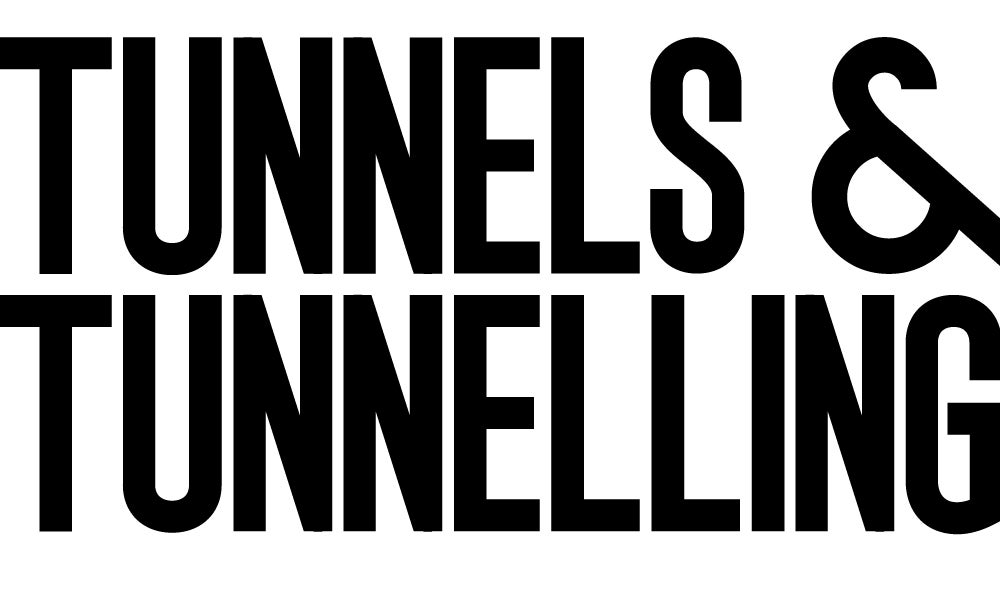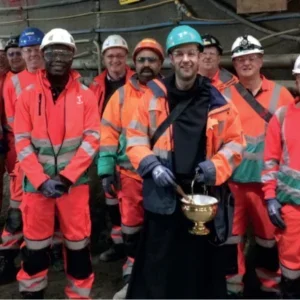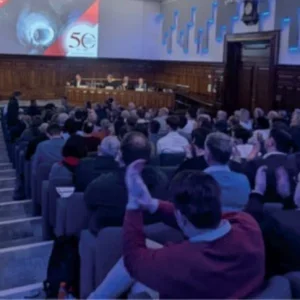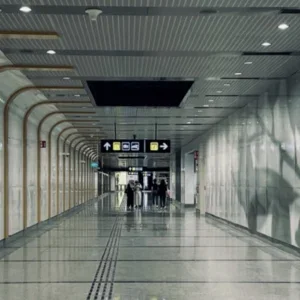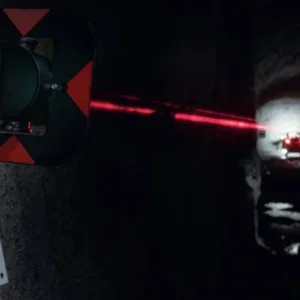The two northern sections of the tunnel represent the “bread and butter” design and construction methodology for the base tunnels it could be said. As with 95 per cent of the tunnel length these drives were through relatively sound hard rock, mostly granite. The design specified TBMs made exceptionally fast progress, even achieving on one section a 56m cut in a single day, a possible world record.
That is not to say the drives were easy or even straightforward. The first and more southerly drive, setting out from an underground starting chamber close to the village of Amsteg, passed under some of the highest mountains on its 11.5km route towards the next section at Sedrun, with overburden reaching as much as 2,000m. It was known this would produce both difficulties with rock heat and in places slower progress with flawed and weaker geology, possibly including squeezing ground. A particularly difficult area was the Intschi zone fairly early on in the drive.
Political difficulties too beset the timetable, affecting the northern drives from Erstfeld where the northern portal is just more than 7km away from the end point at the Amsteg cavern.
Local objections held up the start of work for several years. The canton of Uri and its capital Altdorf wanted an extension to the main base tunnel, which had been a route option, considered in early studies. It would have taken the alignment further through the mountain on the side of the narrow valley, which forms the approach to the Gotthard Pass.
An agreement to build in a stub-tunnel starting point for this option, to go ahead in the future, was eventually made and the drives were started in 2007.
But that came later. While it was under discussion, the work went ahead at Amsteg where the initial 1.8km long access adit was begun in 1999 under an early contract. Local contractor Gebruder Wuest of Lucerne worked with Ast-Holzmann Baugesellschaft of Austria on the 7.8m high tunnel. An Atlas Copco rig was used for the drill and blast.
Work was extended to include excavation of a 100m long chamber for signalling and electrical equipment, the first cross-passage of the Amsteg section and of the first 100m of tunnel of the eastern and the western tubes.
Outside meanwhile one of the main spoil handling sites was set up with a complex of conveyors and crushers.
A contract for the main drives heading south was let to a joint venture of Swiss firm Murer and Austria’s Strabag in late 2001, which ordered two Herrenknecht TBMs for the work.
During the manufacturing of the TBM at Herrenknecht, the contractor built a large chamber 45m long and 20m across for the assembly and various small branch tunnels for conveyors. Another small 1.8km long tunnel to the Amsteg hydroelectric power plant was built by a 3.7m TBM. It was for operational power supplies and could also serve as a second, independent exit during construction.
Cutting diameter of the TBM was a relatively large 9.55m, because the consultant consortium’s design team were anticipating zones of faulted and potentially squeezing rock, which could deform and would eventually require a relatively thick inner lining. The machines, christened Gabi 1 and Gabi 2, were both powered at 3,500kW. They were brought to the start cavern where a large 160t capacity portal crane had been installed for their assembly. Both started out in early 2003.
The machine trains were only partly Herrenknecht, however. Apart from the machine head on hydraulic pads and then a conventional support train running on rails behind it for the first 150m, which contained rock support drills, shotcreting rigs and other equipment, the joint venture elected to use a hanging platform system, using rock bolts and chains.
“The complete backup train was 440m in total and most of that was supported on a mid-level Rowa platform,” says Adrian Wildbolz, the northern section’s overall supervising engineer for the client, AlpTransit Gotthard. The Swiss firm Rowa has made strong headway in the last decade with its concept on many Alpine contracts especially and increasingly worldwide. It uses the rock-bolted chains to support rails along which the platform can move.
“The hanging support allows the contractor to keep most of the static equipment, crushers and conveyors in the top half of the tunnel,” explains Wildbolz, “leaving the bottom section of the tunnel free for mobile equipment.”
In the construction sequence used for the Amsteg drives, an important element was formation of a concreted base slab for the tunnel, which was the permanent support for the final Railtrack eventually and during construction for temporary twin rail track for Schoma locomotives and Mullhauser wagons to supply the machine. A twin track “station” area ran along behind the machine train with one side for men to arrive and the other for materials.
This concrete base was cast in situ with a total 30m of formwork in three 10m sections which were leapfrogged forwards. “Concreting is usually difficult to keep in synchronisation with the excavation,” explains Wildbolz. “In a normal machine train there is a bridge section to clear the formwork. But there is a limit to how long that can be and if the concreting lags behind the cutterhead, you can run out of space. The whole operation has to slow down.
“But with the overhead chain support the train can move on while the concreting is done, and it can catch up later.”
Other work is also done more easily too, he says, including the general moving to and fro needed in all tunnel work. One important operation needing drill rigs and excavators follows on behind to create the small cross passages, for example.
These 20m2 section links, every 312.5m, are made from the more advanced of the two parallel main drives, connecting across the 40m spacing between the tunnels. The drives leave a metre or so of rock at the end, which is broken through finally with an excavator-mounted Montabert hydraulic hammer from the second tunnel when it arrives.
“I’m convinced in this geology that it was clever choice of the contractor to use this Rowa system,” says Wildbolz, adding that the operational flexibility was an important contributor to some very good progress made on the drives, helping cope with the variation in the cutterhead progress.
According to Herrenknecht this ranged from “good monthly performance of 560m and penetration rates of up to 12mm per revolution, followed by difficult stretches, some with a penetration rate of only 3mm per revolution and an advance of only 140m per month.”
Both machines came to the end of their sections early, one with nine months to spare and the other six months. The time gain might have been even greater but for some reorganisation of the tunnels and a significant stoppage on the west drive caused by some unusual loose ground.
Heat caused the initial problem from the rock, which could rise to over 40 degrees centigrade. This was anticipated in all the studies and the contractors had been given warning in their contracts, which set an envelope of expected heat levels, predominantly between 32 and 38 degrees. According to Swiss safety law, which was revised because of Gotthard, working spaces had to be no more than 28 degrees.
Temperatures in the first third of the tunnel were not too problematical, says Wildbolz, but they began to rise faster than expected once the tunnel cover increased towards 2,000m. “The problem is that no-one has any experience of tunnelling at such depth and the temperature curves were estimates from other situations.”
That was initially something for the contractor to sort out, he says, but once it went over the contract-defined limits “it became our problem.” A big increase in cooling equipment was needed, especially at the tunnel face where the newly chipped rock contained the most heat, and where the machinery was generating more calories too.
The tunnel spaces were not cooled with ventilation, because airflow heated up on the way to the tunnel face. Instead, industrial tunnel cooler units were used. These absorb the heat into cold water, which had therefore to be carried in and out of the tunnel in large steel pipes. Four of these as well as four return pipes were used eventually for the two drives, which meant some 100km of pipe work.
“You can imagine the pumping capacity needed,” says Wildbolz. “The electricity for that alone cost CHF 10,000 (USD 10,000) per day.”
Outside there were settlement ponds for water treatment and some cooling and two cooling towers. To cope with the heat the contractor had to add four more bigger cooling towers eventually, says Wildbolz.
The second difficulty was hit about midway into the drive when the two machines ran into some exceptionally difficult rock. “It was a hydrothermally disaggregated material like loose chips for road surfacing,” he explains.
The more advanced of the two drives slowed down, he says and by using closely- spaced arch support and mesh, continued to make headway, even though some of the chips would trickle through.
“But just 40m away the other machine had major problems,” he says. It had advanced a few metres into the material when suddenly there was an inrush of the material into the cutterhead area. “There was just a little water, perhaps 2lt/s, which seems to have made the difference.”
The machine head was jammed and unable to rotate. A small excavation around the side of the head found the material standing, and then it suddenly rushed into the space, he says, “like a waterfall.”
The next few days saw a series of boreholes made, which showed another 20m of the worst ground ahead and an unravelled cavity above the tunnel line.
To tackle this it was decided to make a small tunnel from the opposite bore, where the TBM was steadily moving onwards. From here a fan of grouting tubes could inject a gel grout into the loose material forming a plug around the TBM face. Another tunnel from the opposite bore was started further ahead, curving round back to the TBM where it opened out into a chamber in front of the now immobilised, gel-filled ground around the cutterhead.
Forepoling from the opened-out chamber created a grouted umbrella forwards as far as the machine’s face, allowing access to clean and free it up. “The contractor took the chance to do some repair and maintenance as well,” says Wildbolz.
Some six months progress was lost, he says, before the machine could move again. Despite the halt, progress for the remainder of the drives was good, the drives finishing six months and nine months ahead of schedule respectively.
Further back in the tunnels, work continued on the permanent lining. The contractor started this while the TBM was still at work, with crews forming kicker sections part way around from the base slab, with their drainage and impermeable liners.
These were completed once the cooling pipes and other service lines could be removed and space made for the full diameter formwork. Lining thickness is a minimum 300mm, varying depending on the rock conditions and the loads that implies. It is assumed that the rock support behind the membrane will corrode and that the inner lining must be capable of sustaining the permanent load alone.
Along with the varied amount of steel and shotcrete that might have been needed, this means the inner diameter of the tunnel also varies from point to point. “There is no fixed size, but a minimum usable diameter,” says Wildbolz “the criterion being that the trains require a completely free area of 41m2 from aerodynamic analysis.”
The lining work included installation of unusual precast units for the side walkways that contain most of the ducting for signals and power. The 10m sections were made nearby and allowed much better quality control for the ducting than normal in situ work, thinks Wildbolz.
The second northern drives, which run from the Erstfeld portal to the start chamber at Amsteg, have now been completed by the same contractor, Strabag, which has now bought Murer. It was able to make an offer because the long delay at Esrtfeld meant it had finished the other section.
“The bid included some over-excavation because the required diameter was only 9.4m for the Erstfeld section which has lower overburden,” says Wildbolz.
The contractor’s experience on the first drive and the presence of the existing machines allowed a competitive bid even with the surplus excavation. The set-up used was very similar to the first drives again with conveyor spoil removal and went equally quickly, finishing last year.
The Amsteg sections were lined, completed and handed over earlier this year and much of the inner lining for the Erstfeld section is now done, completely on the east side and about one third on the west.
Rail track work begins here once the rail teams have completed a first section at Bodio in the south and have transferred their equipment.
Sections of cut and cover construction 400m long are being completed at the Erstfeld portal to cope with steep mountains slopes above where rockfall risk is high. The TBM drives started at this end point – Picture courtesy of AlpTransit Gotthard Tunnel section Amsteg The huge cutter head on the TBM is dismantled at the end of the Amsteg drives in 2006 – Picture AlpTransit Gotthard The work site and aggregate facility at Amsteg – Picture AlpTansit Gotthard Cleaning the TBM head once it had been rescued from the disaggregated ground on the Amsteg drive – Picture AlpTransit Gotthard The worksite looking north along the Gotthard approach Impermeable membrane being installed for the lining formwork Rescue sequence for the TBM trapped in disaggregated ground Adrian Wildbolz, Amsteg and Erstfeld section manager for AlpTransit – Picture AlpTransit Gotthard
